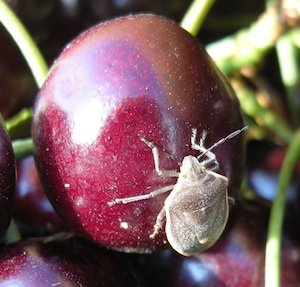
The brown marmorated stinkbug is closing in on cherry and pear orchards in Oregon’s Mid-Columbia region. (Courtesy of Washington State University)
Scientists at Oregon State University are on the trail of the brown marmorated stinkbug, which they found near the train station in downtown Hood River, Oregon, earlier this month.
The recent finds bring the dreaded bug perilously close to the region’s pear and cherry orchards. The brown marmorated stinkbug, which has devastated fruit crops on the Atlantic coast, has been in Portland, Oregon, since 2004. Judging by subsequent detections, it’s been working its way east along the Columbia River, and has been reported in Arlington, in eastern Oregon, where it’s presumed to have arrived with garbage trucked from Portland to the landfill there.
The bug attacks a wide range of pests, from grains, corn, and soybeans, to grapes, tree fruits, and ornamentals. It did major damage to orchards in the Mid-Atlantic region in 2010—especially in Pennsylvania, where it destroyed more than half of the peach crop. It’s now in at least 27 states.
“This is one of the worst agricultural pests I have seen in my career,” said Peter Shearer, entomologist and director of OSU’s Mid-Columbia Agricultural Research and Extension Center in Hood River.
The pest has the potential to disrupt the softer pest management programs that tree fruit growers have been adopting, and to derail efforts to enhance biological control of orchard pests, he said. “This has the potential to throw that all out the window, because the products that are effective against the stinkbug are disruptive of our natural enemies and IPM programs. It’s very disheartening what this could do to our industries.”
Dr. Nik Wiman, a postdoctoral researcher based in Corvallis, Oregon, has been working with Shearer in a national research project to tackle the bug. Wiman is systematically surveying northern Oregon to learn about the distribution of the pest.
He found the Hood River bugs within an hour of going out looking for them on June 14. He took a beating tray sample in a tree of heaven growing near the station, and found seven bugs. Shearer went back to the same location several days later and found another four in a different tree of heaven. Most of the bugs were female and began laying eggs immediately after being taken back to Shearer’s lab. It’s suspected that some might have already laid eggs before being caught.
Dr. Steve Castagnoli, OSU extension agent in Hood River, said the tree of heaven (Ailanthus altissima) is a weedy tree that gives off aromatic compounds that are attractive to the bug. The tree is a native of China, where the bug also originated, and is commonly found on disturbed sites, including railway rights of way.
“That’s a scary plant,” Shearer commented. “It’s a very weedy, invasive species.”
Hitchhike
This is not the first detection of the brown marmorated stinkbug in Hood River. Last fall, staff at the Research and Extension Center found a bug on a railing outside their building. Shearer said they thoroughly checked the station and its outbuildings but never found another bug. Their theory is that the lone specimen arrived on a delivery truck.
Shearer said the bug appears to have an aptitude for hitchhiking and is probably being moved around by trucks, trains, and tourists in recreational vehicles. Its spread seems inevitable.
Natural enemies
A long-term solution that is being explored is the release of natural enemies of the bug, but Shearer said scientists need to make sure that releasing the natural enemies causes no other problems. The benefits and risks will need to be studied.
Shearer said OSU scientists are meanwhile trying to delineate the distribution of the pest and monitor its spread.
“I really think we have a couple of years before it becomes an issue in orchards here in the Mid-Columbia area and in Washington State, although this may be the year we find it attacking commercial crops in the Willamette Valley, because it’s been there longer,” he said.
“My experience with this insect is it takes a while to build up before it becomes an outbreak. I am sticking my neck out, but I really feel we have a couple of years to become more prepared, and, hopefully, we will have some solutions by then.
“In the meantime, it’s important that the industry recognize them and that the general population is aware of this and can report it to the local extension office so we can track the spread of this. This is a serious threat.”

Leave A Comment